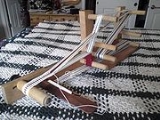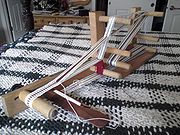
Inkle weaving
Encyclopedia
Inkle weaving is a type of warp-faced weaving
where the shed
is created by manually raising or lowering the warp
yarns, some of which are held in place by fixed heddle
s on a loom known as an inkle loom. Inkle weaving was referred to in Shakespeare's Love's Labour's Lost
. It was brought to the United States in the 1930s, but predates this by many centuries in other countries. The term "Inkle" simply means "ribbon" or "tape" and probably refers to a similarly structured woven good that could have been made on different types of looms, such as a box-loom.
Inkle weaving is commonly used for narrow work such as trims, straps and belts.
 Inkle looms are constructed in both floor and table-top models. Either model is characterized by a wooden framework upon which dowels have been fastened. These dowels will hold the warp threads when the loom has been dressed.
Inkle looms are constructed in both floor and table-top models. Either model is characterized by a wooden framework upon which dowels have been fastened. These dowels will hold the warp threads when the loom has been dressed.
One of the dowels, or a paddle, is constructed so that its position can be adjusted. This tensioning device will be taken in as weaving commences and the warp threads become shorter.
Additional equipment includes yarn of the weaver's choice, yarn or thread for forming heddles and a shuttle to hold the weft. A notebook is also handy for charting weaving diagrams.
A simple raising and lowering of threads creates a plain-weave band in which warp threads are slightly offset. Weft threads are only visible at the edges of the band and the weaver may wish to take this into account by warping threads that will form the edges in the same color as the weft.
As the weaving commences, the warp threads will shorten on the loom and the weaver will need to adjust the tension periodically. As the inkle band progresses, it will also get closer to the heddles. The weaver will also need to advance the warp thread along the bottom of the loom to open up new weaving space. In her book "Inkle Weaving," Helene Bress recommends loosening the tension when you are ready to advance the warp. Once you have done so, tighten the tension again and resume your weaving.
There are other more advanced techniques in which, instead of merely allowing warp threads to alternate in their up or down positions, individual threads are brought to the surface to form what is called a "pick up" pattern. One side of the band will show the exposed surfaces of warp threads while, on the other side of the pattern, the weft thread will be visible. Using a supplemental weft thread that will come up over the top of certain warp threads, brocaded designs can also be worked into the inkle band.
An inkle loom is also useful in the practice of tablet weaving
for its added portability. Simply thread the warp onto the loom but use cards instead of alternating between free-hanging and heddle-secured yarn.
Brown, Rachel. The Weaving, Spinning, and Dyeing Book Second Edition Alfred A. Knopf, New York, 1983, ISBN 0394715950
Folts, Teressa. The inkle path to weaving Serenity Weavers, 1977.
Holland, Nina. Inkle loom weaving Watson-Guptill Publications, 1973. ISBN 0823025519
Holland, Nina. The Weaving Primer : A complete guide to Inkle, Backstrap, and Frame Looms Chilton Book Co., 1978. ISBN 0801966256
Tidball, Harriet. Weaving Inkle Bands Shuttle Craft Books Inc. 1969. ISBN 0916658279
Sutton, Ann & Collingwood, Peter. The craft of the weaver Lark Books, 1983. ISBN 0937274100
Weaving
Weaving is a method of fabric production in which two distinct sets of yarns or threads are interlaced at right angles to form a fabric or cloth. The other methods are knitting, lace making and felting. The longitudinal threads are called the warp and the lateral threads are the weft or filling...
where the shed
Shed (weaving)
In weaving, the shed is the temporary separation between upper and lower warp yarns through which the weft is woven. The shed is created to make it easy to interlace the weft into the warp and thus create woven fabric. Most types of looms have some sort of device which separates some of the warp...
is created by manually raising or lowering the warp
Warp (weaving)
In weaving cloth, the warp is the set of lengthwise yarns that are held in tension on a frame or loom. The yarn that is inserted over-and-under the warp threads is called the weft, woof, or filler. Each individual warp thread in a fabric is called a warp end or end. Warp means "that which is thrown...
yarns, some of which are held in place by fixed heddle
Heddle
A heddle is an integral part of a loom. Each thread in the warp passes through a heddle, which is used to separate the warp threads for the passage of the weft. The typical heddle is made of cord or wire, and is suspended on a shaft of a loom. Each heddle has an eye in the center where the warp is...
s on a loom known as an inkle loom. Inkle weaving was referred to in Shakespeare's Love's Labour's Lost
Love's Labour's Lost
Love's Labour's Lost is one of William Shakespeare's early comedies, believed to have been written in the mid-1590s, and first published in 1598.-Title:...
. It was brought to the United States in the 1930s, but predates this by many centuries in other countries. The term "Inkle" simply means "ribbon" or "tape" and probably refers to a similarly structured woven good that could have been made on different types of looms, such as a box-loom.
Inkle weaving is commonly used for narrow work such as trims, straps and belts.
Equipment

One of the dowels, or a paddle, is constructed so that its position can be adjusted. This tensioning device will be taken in as weaving commences and the warp threads become shorter.
Additional equipment includes yarn of the weaver's choice, yarn or thread for forming heddles and a shuttle to hold the weft. A notebook is also handy for charting weaving diagrams.
Process
The inkle loom is threaded with warp threads according to the weaver's design, alternating between yarn that that can be raised and lowered and yarn that is secured in place through the use of the heddles. The raising and lowering of these warp threads creates the shed through which the weft thread will be carried on a shuttle. The weaver should make one pass with the shuttle with each opening of a shed through the raising and lowering of threads.A simple raising and lowering of threads creates a plain-weave band in which warp threads are slightly offset. Weft threads are only visible at the edges of the band and the weaver may wish to take this into account by warping threads that will form the edges in the same color as the weft.
As the weaving commences, the warp threads will shorten on the loom and the weaver will need to adjust the tension periodically. As the inkle band progresses, it will also get closer to the heddles. The weaver will also need to advance the warp thread along the bottom of the loom to open up new weaving space. In her book "Inkle Weaving," Helene Bress recommends loosening the tension when you are ready to advance the warp. Once you have done so, tighten the tension again and resume your weaving.
There are other more advanced techniques in which, instead of merely allowing warp threads to alternate in their up or down positions, individual threads are brought to the surface to form what is called a "pick up" pattern. One side of the band will show the exposed surfaces of warp threads while, on the other side of the pattern, the weft thread will be visible. Using a supplemental weft thread that will come up over the top of certain warp threads, brocaded designs can also be worked into the inkle band.
An inkle loom is also useful in the practice of tablet weaving
Tablet weaving
Tablet Weaving is a weaving technique where tablets or cards are used to create the shed through which the weft is passed. The technique is limited to narrow work such as belts, straps, or garment trim....
for its added portability. Simply thread the warp onto the loom but use cards instead of alternating between free-hanging and heddle-secured yarn.
Uses for inkle weaving
The narrow bands that inkle weaving forms are ideal for use as belts, trims, straps, ribbons, or garment hem decorations, for instance. The many varieties of color and pattern are limited only by the weaver's imagination.Recommended reading
Bress, Helene. Inkle Weaving. Flower Valley Press / Scribner, 1975, ISBN 0801966256Brown, Rachel. The Weaving, Spinning, and Dyeing Book Second Edition Alfred A. Knopf, New York, 1983, ISBN 0394715950
Folts, Teressa. The inkle path to weaving Serenity Weavers, 1977.
Holland, Nina. Inkle loom weaving Watson-Guptill Publications, 1973. ISBN 0823025519
Holland, Nina. The Weaving Primer : A complete guide to Inkle, Backstrap, and Frame Looms Chilton Book Co., 1978. ISBN 0801966256
Tidball, Harriet. Weaving Inkle Bands Shuttle Craft Books Inc. 1969. ISBN 0916658279
Sutton, Ann & Collingwood, Peter. The craft of the weaver Lark Books, 1983. ISBN 0937274100

